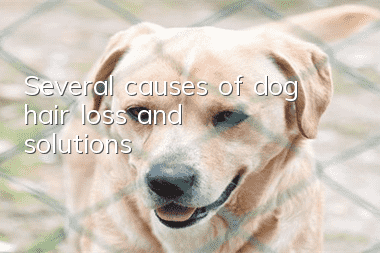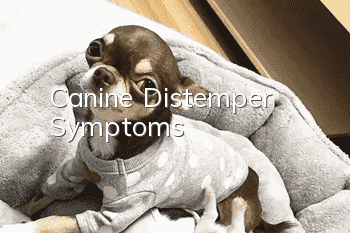Several causes of dog hair loss and solutions!

Many dog owners are worried about one thing, especially if they have dogs with long hair and easy shedding. Every time it is shedding season, pet parents will feel very annoyed, because they often cause the whole house to fall apart without paying attention. There is dog hair flying everywhere.
If the dog sheds a lot of hair due to normal hair shedding, just clean it regularly. If hair loss is caused by malnutrition, parasite infection, or skin disease, it is necessary to seek medical treatment in time and give the dog a full body examination before prescribing appropriate treatment.
Next, let’s take a deeper look at the several causes of dog hair loss and learn solutions to different levels of hair loss!
Physiological causes of hair loss
1. Fertility period
Dogs will lose a lot of hair after giving birth, which will also be accompanied by weight loss, emaciation, etc. At this time, more attention should be paid to the amount of nutritional supplements given to the female dog.
2. Growth process
Normal metabolism will cause hair loss in pets. Just like human hair, it continues to grow, die, fall off, and replace. In addition, some types of pets may also experience hair loss during the transition from childhood to adulthood.
3. Estrus period in the elderly
Dogs in estrus may also lose hair due to hormonal changes in their bodies. Older dogs will lose hair due to their slow metabolism. Dogs need to pay attention to the supply of nutrients after entering their old age and eat professional old age dog food.
4. Caused by the change of seasons
Dogs will respond to temperature differences caused by seasonal changes through their own adjustments. Therefore, when the temperature rises or falls, dogs will undergo normal hair shedding to adapt to the temperature. Dogs ranging from Samoyeds and Alaskans to Bichon Frize Pomeranians have a normal shedding period. In order to withstand the cold of winter, dogs will shed their coarse fur that helps dissipate heat in autumn and replace it with warm and comfortable down. In spring The downy hair in winter will be replaced by coarse hair that is good for heat dissipation and breathability, so it is normal for dogs to shed a lot of hair during the change of seasons.
Causes of pathological hair loss
1. Excessive cleaning
Some owners bathe their pets frequently in order to keep them clean. Excessive cleaning will destroy the pH balance of the pet's skin and cause hair loss.
2. Skin diseases
Dogs are infected with skin diseasesLater, if there are diseases such as folliculitis or eczema caused by mites, fungi and other parasites, bacteria, or a large number of dog lice and fleas, the dog will scratch its fur with its claws and teeth due to severe itching, so it will scratch and lose a lot of hair. .
3. Excessive salt intake
The salt that dogs need is different from that of humans. Eating too much salt will cause hair loss, including spicy and irritating foods. In addition, eating too much salt will also increase the load on the dog's internal organs, so you should eat professional food. Nutritionally proportioned cat food and dog food.
4. Nutritional malnutrition
Dog hair loss is caused by malnutrition, nutritional imbalance, and lack of vitamins and minerals.
5. Too little sunshine
Appropriate sunlight exposure is beneficial to the health of the dog's coat. Long-term lack of sunlight exposure will cause hair loss.
6. Caused by emotions
Fear, tension, and anxiety can cause hair loss in dogs. Therefore, owners should interact with their pets frequently to comfort them and eliminate their pets' tension and fear.
How to clean dog hair on a daily basis
1. Use a pet-specific brush
Use a special brush to comb your pet's hair once or twice a day, so that the shed dog hair is concentrated on the brush and disposed of at once, so that the dog hair will not be all over the home.
2. Use sticky glue roller
There is a dust-sticking glue roller on the market. Use it to roll it on the bed or sofa, and you can stick the hair to the glue roller, which is convenient for quick hair treatment.
3. Sprinkle some water when sweeping the floor
Dog hair is thin and soft, easily floating in the air, and difficult to gather when sweeping. Before sweeping the floor, spray a small amount of water in the air and on the ground (a humidifier will also work), and then wipe the floor with a clean rag. With the condensation of water, dog hair will form into small clumps, making it easier to find, collect and process.
4. Use a vacuum cleaner
For furniture such as beds, carpets or fabric sofas, it is best to vacuum them every day. Especially under the bed and sofa, you need to clean them carefully. Finally, wipe the floor with a clean mop, and wipe tables, bedsides, bookcases and other smooth surfaces with a clean rag.
Several common skin diseases causeSymptoms of hair loss
1. Acariasis: caused by scabies or demodex mites.
Scabies mites mainly occur on the head (bridge of the nose, eye sockets, auricles and their roots), sometimes on the chest, abdomen, armpits, inner thighs and tail, and even spread to the whole body. The skin surface is flushed with rash-like nodules, the subcutaneous tissue is thickened, and the affected skin becomes hairless due to frequent scratching, friction, and biting.
Demodex mites mainly form small hair loss spots around the eyes, and some can extend to the whole body. The affected area of skin becomes thickened and scaly, and some may develop into small pustules or purulent dermatitis.
2. Tinea alopecia
It is mainly a fungal disease caused by Microsporum and Trichophyton in dogs. The course of the disease is long. Round or irregular bald spots appear on the skin, covered with gray-white scales. They are more common on the head, neck and limbs. In severe cases, they can form one patch and affect most of the body surface. Sometimes accompanied by dermatitis, papules or pustules.
3. Lice Disease
Itching and skin irritation caused by lice parasitism, which leads to scratching, friction and biting. The coat of the affected area is rough and dull, easy to break and fall off. In particular, the parasitism of hair lice can cause a large amount of hair loss in dogs, and a large amount of shed hair can be found in places where dogs frequently move.
4. Vitamin deficiency
Vitamin B deficiency can also cause hair loss, as well as symptoms such as weight loss, anorexia, general weakness, and vision loss or loss.
5. Hookworm disease
Affected dogs are emaciated, have pale conjunctiva, coarse and matte hair that is easy to break and fall off. Hair loss spots of varying sizes often appear on the back, exposing the skin, and papules or scabs appear on the skin.
How to deal with common skin diseases
The first step: kill mites and sterilize, remove mite fungi on the body surface
Step 2: Get rid of various parasites inside and outside the body
Step 3: Repair skin, promote hair growth, enhance resistance, and supplement vitamins
Note:
1. The symptoms of hair loss in dogs are obvious. The key is to correctly identify the cause, treat the primary disease, and treat the symptoms at the same time.
2. The dog’s living environment should be kept dry, disinfected regularly, and pathogenic microorganisms should be killed. If necessary, the pet dog should be equipped with an insect-proof collar.
3. Comprehensively strengthen the dog’s nutrition and provide sufficientof protein, vitamins and trace elements to improve resistance.
4. Remember to blow-dry your hair every time you take a shower!
- What to do if a puppy bites a chicken
- What are the treatments for Shiba Inu vomiting?
- How old can a dog take a bath?
- Be alert! List of dog food taboos!
- Canine Impetigo Causes | Diagnosis | Prevention and Treatment Methods
- How much does a black Labrador retriever cost? Black Labrador retriever price!
- Things to note when raising a Pomeranian
- Causes and Treatment of Abscesses in Dogs
- The dog suddenly twitched and recovered after a while
- How to Treat Puppy Coronavirus



